Pioneer women made soap by collecting animal fats from cooking and extracting lye from wood ashes. They'd boil this mixture in large kettles over open fires, testing thickness by observing how it dripped from a spoon. The resulting soft soap was stored in wooden barrels for household cleaning. They also incorporated local herbs like peppermint, sage, and yarrow for medicinal benefits. These resourceful cleansing methods reveal much about frontier ingenuity and self-sufficiency.
The Pioneer Woman's Soap Making Toolkit
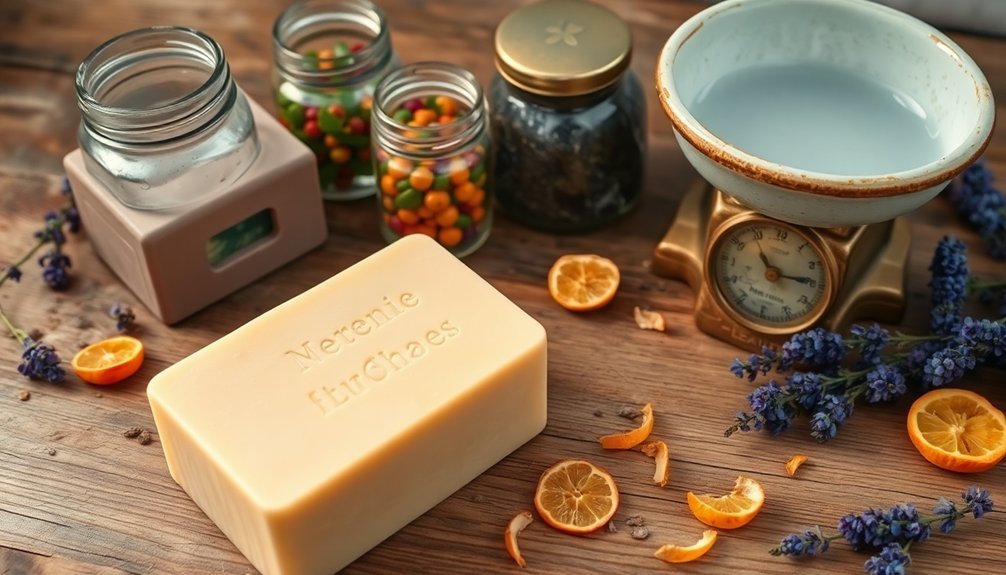
Ingenuity defined the pioneer woman's approach to soap making, an essential domestic skill that relied on a specific set of ingredients and tools.
You'd find her collecting animal fats and grease from daily cooking, carefully saving these precious resources for batch preparation.
Her toolkit consisted of large kettles suspended over open fires, wooden barrels for storing soft soap, and sometimes sassfras sticks for stirring the bubbling mixture.
She'd construct ash hoppers to collect lye from wood ashes, gathering the caustic liquid in clay vessels below.
The process required patience – rendering fat, combining it with lye solution, and boiling until the mixture thickened properly.
Without modern testing methods, she relied on experience, watching for the mixture to track (leave trails) when dripped from a spoon.
The final product consisted of approximately 75% soap and 25% glycerin, resulting from the saponification process that transformed the raw ingredients.
Lye Extraction From Wood Ash: a Lost Art
While soap making formed the backbone of pioneer cleanliness, the process truly began with the essential skill of lye extraction from wood ash.
You'd carefully collect ashes from hardwood fires—hickory, sugar maple, and beech were prized for their high alkali content. Softwoods were avoided due to their resin content.
Using a leaching barrel lined with pebbles and straw, you'd pour water through the ashes, collecting the resulting lye solution in a trough below. Alternatively, you might boil the ash-water mixture for half an hour, then skim off the lye.
This labor-intensive process required proper equipment—wooden or stainless steel tools, never aluminum due to lye's corrosive nature. Testing the lye's strength was often done by checking if it could float an egg in the solution.
Though largely forgotten today, this self-sufficient practice preserves pioneer resourcefulness for modern enthusiasts.
Fat Rendering Techniques for Homemade Soap
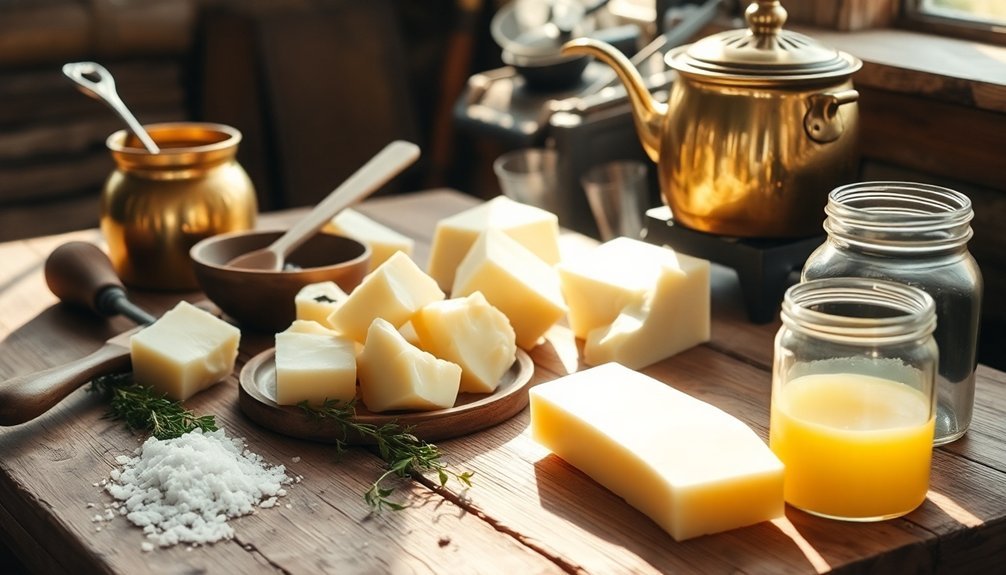
You'll need to collect beef suet or mutton fat and render it by simmering with water and salt until the tallow separates from impurities.
Once the mixture cools, you can pry off the solidified white tallow disc and clean it thoroughly before mixing with lye solution at approximately 125°F.
The combination of properly rendered tallow and carefully prepared lye creates the foundation for pioneer women's homemade soap, which required curing in molds before use. This process transforms waste into a useful product through saponification process, supporting the sustainable practices that were essential to pioneer living.
Tallow Collection Methods
Pioneer women relied on two primary rendering techniques to transform animal fat into the versatile tallow needed for soap-making. They'd carefully source high-quality suet—particularly from around cow kidneys—or collect beef trimmings from butchering days.
These raw materials were then processed through either wet or dry rendering methods, with dry rendering being preferred for its simplicity and lower risk of spoilage. This tradition of skillful tallow preparation continued through the 18th century when both genders commonly used tallow-based soaps for cleansing.
The collection process typically involved:
- Requesting kidney fat (suet) from local butchers or saving it from their own livestock
- Cutting the fat into small, uniform cubes to guarantee even melting
- Using a dedicated stock pot or slow cooker for the rendering process
- Straining the rendered tallow through cheesecloth to remove impurities and extend shelf life
Soap-Making Lye Processes
Three essential components formed the foundation of pioneer soap-making: animal fat, lye, and water. You'd create lye by placing wood ashes in a barrel with small holes at the bottom, then slowly pouring water through the ashes. The resulting brown liquid contained potassium hydroxide—your homemade lye. This soap-making process was typically performed outdoors to eliminate the unpleasant odors produced during rendering.
| Process Step | Description |
|---|---|
| Ash Collection | Hardwood ashes gathered after cooking fires |
| Leaching | Water poured through ashes to extract lye |
| Testing Strength | Floating an egg or potato to check concentration |
| Storage | Kept in wooden containers until needed |
Testing lye strength was essential—if an egg floated with a coin-sized portion above the surface, your lye was ready. Too weak, and your soap wouldn't form; too strong, and it would be dangerously caustic.
Essential Soap Molds and Cutting Implements
Wooden frames and barrels formed the backbone of pioneer soap production, serving as essential molds for the cooling and hardening process.
Once poured, the soap would set before being removed and cut into usable bars with metal knives or specialized cutting tools.
The size and consistency of soap bars mattered for both practical use and possible sale, with different regions developing unique cutting methods:
- Large wooden frames created substantial blocks that could be divided as needed
- Manual cutting required patience and skill to maintain uniform bar sizes
- Soft soap required different molding techniques than hard soap
- The availability of materials like wood directly influenced mold design and construction
Without salt to create hard soap, many pioneers relied on softer varieties that affected both storage and molding practices.
Pioneer women understood that the saponification process required sufficient time for the lye to fully react with the animal fats before cutting their soap into usable pieces.
Documented Recipe Variations Across Pioneer Territories
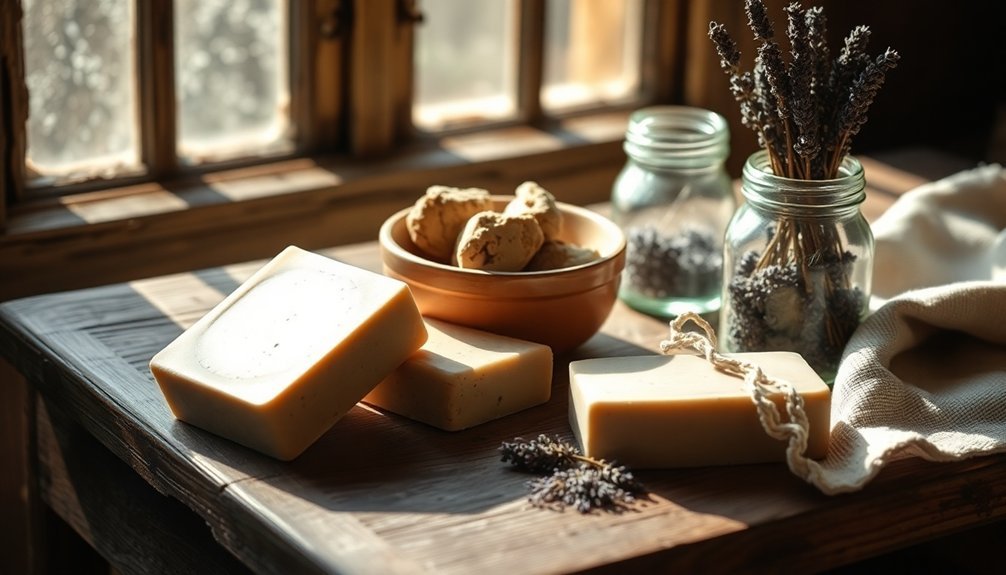
You'll find fascinating differences in soap recipes as you travel across pioneer territories, from the pine-infused formulations of the Northeast to the desert plant variations in the Southwest.
Women in the Great Plains often incorporated prairie herbs like yarrow into their cleansers, while those in coastal regions utilized seaweed ash for its higher mineral content. Pioneer women commonly used a simple mixture of white vinegar and water for everyday cleaning tasks, much like modern DIY cleaning solutions.
These territory-specific cleaning remedies reflected both the available local resources and the unique challenges posed by regional climate conditions.
Regional Soap Formulations
Across America's expanding frontier, pioneer women developed distinct soap recipes reflecting their local environments and available resources. These regional variations emerged from necessity, as settlers adapted to the materials at hand.
- New England formulations incorporated maple syrup for moisturizing properties, creating a softer soap that was gentler on skin during harsh winters.
- Southern recipes utilized abundant lard and cottonseed oil, producing a creamier consistency ideal for personal hygiene. Many southern pioneers would cook their soap in large cast-iron pots similar to those used for making hearty potato soups and stews.
- Western frontier households relied heavily on plant ashes when traditional firewood was scarce, resulting in a stronger alkaline soap.
- Appalachian communities added juniper berries for both fragrance and medicinal benefits, addressing multiple needs with a single product.
You'd find that regardless of region, soap making remained an essential communal activity, representing both survival necessity and practical artistry in pioneer life.
Territory-Specific Cleansing Remedies
Pioneer women developed distinct cleansing remedies based on the territories they settled, adapting their traditional knowledge to local resources.
In eastern regions, you'd find cleaners infused with mint and chamomile, while southern households relied on lard and ash combinations when lye was unavailable.
If you lived on the western frontier, you'd depend heavily on baking soda and vinegar due to their accessibility.
Coastal dwellers ingeniously incorporated sea salt and oceanic plants into their cleansing routines.
In mountainous areas, you could find pine tar being used for stubborn cleaning challenges.
These regional adaptations weren't developed in isolation.
You'd often see knowledge exchanged during community gatherings, with Native American tribes contributing valuable insights about plant-based agents and European settlers introducing alternative soap-making techniques.
Similar to Ree Drummond's focus on reducing food waste in her kitchen organization, pioneer women were incredibly resourceful with their available materials.
Medicinal Herbs and Their Cleansing Properties
Medicinal herbs served as essential remedies in pioneer women's cleansing routines, offering natural solutions for both internal and external purification.
These women relied on nature's pharmacy for maintaining health on the frontier. Peppermint was especially valued for its vitamin C content that naturally fortified the immune system during harsh frontier conditions.
- Dandelion and burdock root were prized for internal cleansing, stimulating digestion and supporting kidney function when brewed as bitter teas.
- Sage and peppermint featured prominently in pioneer medicine cabinets, aiding digestion and boosting immunity.
- Red clover and nettle served as spring tonics, helping to purify blood after long winters with limited fresh food.
- Milk thistle and turmeric protected liver health, particularly important when clean water was scarce and environmental toxins were common.
Pioneer women prepared these herbs as teas, tinctures, and infusions, often growing them in kitchen gardens for year-round access.
Pioneer Soap Making Timeline and Seasonal Considerations
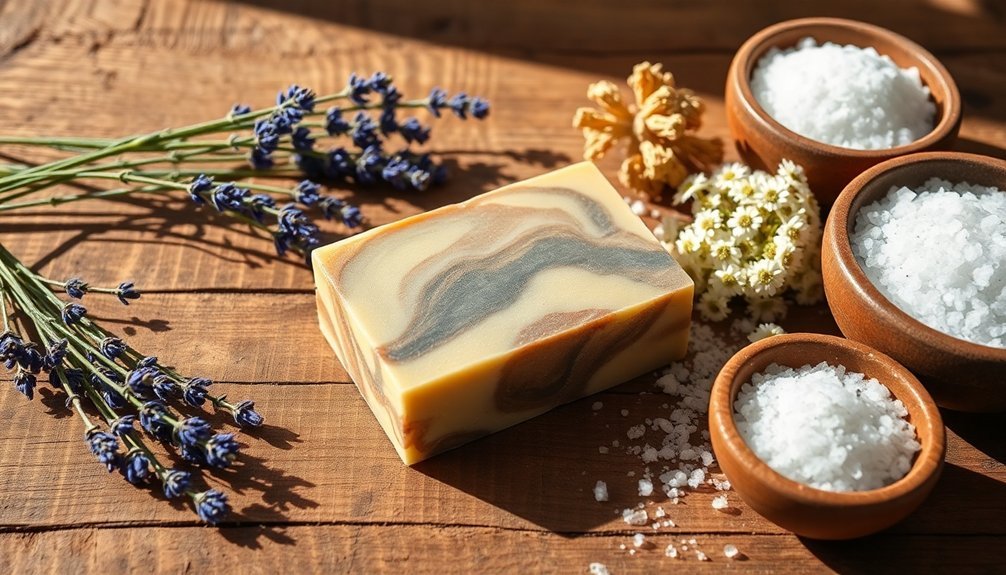
You'd find pioneer women making soap primarily during winter months when fresh animal fat from butchering and abundant wood ashes from heating were readily available.
The seasonal process of soap production typically began with collecting wood ashes in hoppers, then leaching them with water to extract the critical lye component needed for saponification. This technique mirrors the ancient methods documented in early soap recipes found on clay tablets from Babylonian civilizations.
Winter's cooler temperatures also provided practical advantages for the soap-making process, allowing better preservation of ingredients and creating ideal conditions for the weeks-long curing period.
Seasonal Soap Production
The rhythm of soap production followed nature's calendar, with two major soap-making periods emerging throughout the pioneer year. Your pioneer ancestors carefully planned their soap crafting around resource availability and practical needs.
- Spring soap making utilized accumulated winter cooking grease and ash from heating fires, taking advantage of warmer weather for outdoor production.
- Fall soap making coincided with butchering season, when fresh tallow and lard became abundantly available.
- Weather considerations affected the process noticeably, as rainy conditions could dilute lye or prevent proper drying.
- Storage planning was essential, requiring you to carefully preserve fats and ashes between seasons to guarantee you'd have necessary ingredients when needed. The entire soap making process could take six to eight hours depending on the size of the mixture being prepared.
This seasonal approach to soap making reflected pioneers' deep connection to natural cycles and resourcefulness.
Lye Harvesting Cycles
Pioneer women established careful lye harvesting routines that followed the seasonal availability of resources throughout the year.
Winter provided the perfect opportunity to collect abundant wood ash from heating stoves, which you'd store in covered hoppers protected from rain. They specifically sought out hardwood trees like hickory for their optimal lye production capabilities.
Come spring, you'd pour water through these collected ashes, capturing the resulting lye solution in vessels positioned beneath the hopper.
Testing the solution's strength by floating an egg helped you determine if it needed concentration through boiling or dilution with water.
The soap-making process typically aligned with spring hog butchering, when fresh lard became available.
You'd combine your winter-collected lye with rendered fats, stirring continuously over an open fire.
The finished soap would then cure for weeks, becoming ready just in time for summer's heavy laundry demands.
Specialty Soaps for Laundry, Dishes, and Personal Use
Resourceful women of the American frontier developed specialized soaps for every household need, adapting their formulas to specific cleaning tasks.
They crafted distinct varieties depending on whether they were washing clothes, scrubbing dishes, or cleansing their families' skin.
- Laundry soap contained higher lye concentrations with animal fat and sometimes abrasives like sand or ash for tackling stubborn stains on work clothes.
- Dish cleansers utilized boiled lard mixtures followed by sanitizing rinses in boiling water.
- Personal hygiene bars incorporated gentler ingredients such as herbs, milk, or plant extracts to protect sensitive skin. These gentler soap formulations reflected pioneers' practical understanding of skin protection principles, similar to how they used long sleeves and sunbonnets to shield themselves from harsh elements.
- Pot scrubbers often included extra abrasives specifically formulated for cast iron cookware that required special maintenance.
You'll notice these pioneer formulations mirrored modern specialized cleaners, though created entirely from locally available materials and passed-down knowledge.
Soap Making Challenges on the Frontier
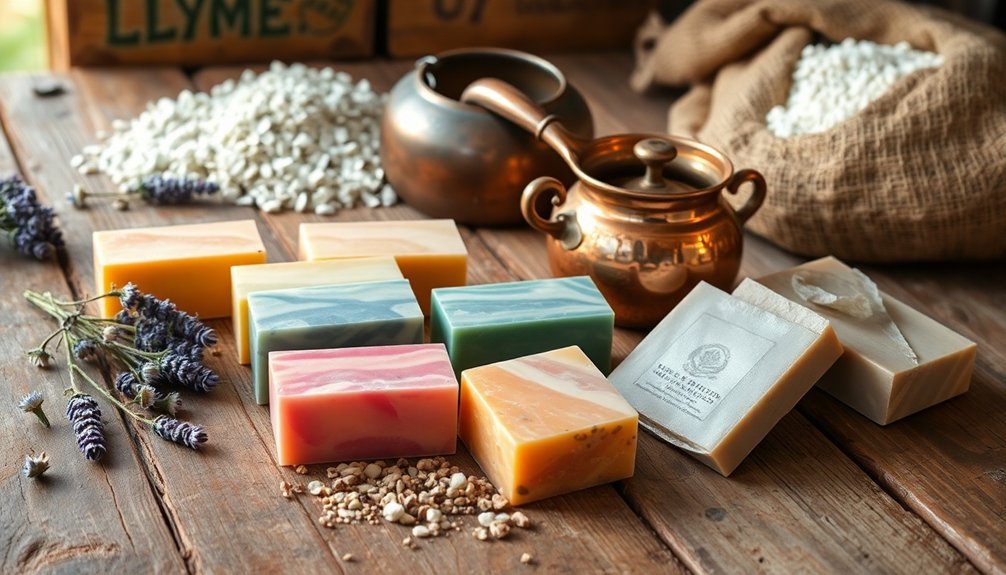
While frontier women crafted specialized soaps for various purposes, they faced numerous obstacles that made soap production a formidable task. You'd need to spend six to eight hours stirring a dangerous mixture over an open fire, often during harsh weather conditions.
Resources were severely limited. You'd scavenge for fat from butchered animals, collect ashes from burned forests for potash, and haul water from natural springs.
Women bore this responsibility while balancing other survival tasks. Similar to colonial women's labor, this domestic work was expected despite being difficult, unpleasant, and without recognition. The isolation meant you couldn't easily trade for ingredients—everything had to be locally sourced.
You'd develop innovative recipes using available herbs and materials, adapting to seasonal changes and resource scarcity. Economic hardship made every ingredient precious, forcing you to integrate soap making into broader family survival strategies.
Preserving and Storing Handcrafted Soaps
After producing soap through the laborious process of combining lye and fat, frontier women faced the equally important challenge of proper preservation and storage.
They understood that properly stored soap lasted longer and performed better.
Pioneer women preserved their handcrafted soaps using these practical methods:
- Allowing bars to cure on wooden shelves or racks in open air, never in airtight containers that would trap moisture.
- Storing soap in cool, dry locations away from direct sunlight to prevent color fading.
- Regularly turning the soap bars to guarantee uniform drying on all sides.
- Using specialized shelving or repurposed materials like wooden crates with adequate ventilation.
They knew that well-cured soap hardened over time, improving its cleaning properties and extending its usable life on the frontier. Once fully cured, many pioneer women would carve the soap into convenient squares for everyday household use.
Cultural Exchange: Native American Influences on Pioneer Cleansing
Beyond the practical methods of soap-making, pioneer women's cleansing practices were profoundly shaped by interactions with indigenous communities.
Native American medicine men used sage and other plants for purification rituals—practices that pioneers readily adopted. You'll find that this cultural exchange introduced herbs like mullein, sassafras, and echinacea into pioneer hygiene routines.
As settlers observed the reverence indigenous people showed toward botanicals, they incorporated these sustainable approaches into their own lives.
Herbal teas for immune support became commonplace, while spiritual purification through sage smoke cleansing offered dual benefits for both home and health.
Community healers often blended Native wisdom with European folk traditions, creating unique healing methodologies that respected nature's offerings while addressing practical cleansing needs. Many tribal healers, particularly those from Caddo tribes, were recognized for their exceptional proficiency in healing arts and shared their knowledge of medicinal plants with pioneer women.
From Pioneer Methods to Early Commercial Soap Production
As pioneers settled into more established communities in the mid-19th century, the laborious process of homemade soap production gradually gave way to commercial alternatives.
This change notably altered household routines and cleaning practices across America. Many families adopted natural products for a healthier home environment while transitioning to commercial soaps.
The shift to store-bought soap offered several advantages:
- Time efficiency – families no longer needed to spend days collecting ashes and rendering tallow
- Consistent quality – commercial products provided reliable results without the guesswork of homemade lye strengths
- Specialized formulations – purpose-specific soaps became available for laundry, dishes, and personal hygiene
- Convenience – ready-made soap eliminated the need for storage space for ingredients and soap-making equipment
Despite these benefits, commercial soap's higher cost meant many families continued making their own soap alongside purchased products.
Frequently Asked Questions
How Did Pioneer Women Clean Their Hair Without Modern Shampoo?
You'd clean your hair by brushing thoroughly, using natural ingredients like egg mixtures, plant extracts, vinegar rinses, and mild soaps. You'd rely on caps and veils to absorb oils between infrequent washes.
What Alternatives Did Pioneers Use When Soap Ingredients Were Scarce?
When soap ingredients were scarce, you'd turn to natural alternatives like ashes mixed with water, sand for scrubbing, vinegar solutions, herbal infusions, or clay and mud for cleaning your body, clothes and surfaces.
How Did Pioneer Women Manage Menstrual Hygiene?
You'd use washable rags, cloth strips, or homemade flannel pads. You'd repurpose available materials like wool or moss when necessary. Without commercial products, you'd wash and reuse these items despite the challenges of limited privacy.
Did Pioneers Have Specific Dental Cleaning Practices?
Yes, you'd find pioneers using animal-hair toothbrushes with wooden handles, homemade tooth powders, or simply chew sticks. Without specialist care, they relied on these basic methods for maintaining dental hygiene.
How Were Babies and Diapers Cleaned in Pioneer Households?
You'd rinse wet diapers if water was available, often just hanging them to dry. You'd only fully wash heavily soiled ones. Diaper rash was treated with burnt flour or powdered sulfur despite sanitation challenges.
In Summary
You've explored the frontier world of pioneer cleansing through their ingenious soap making practices. From extracting lye from wood ash to rendering animal fats, these resilient women created essential cleansers with limited resources. You've seen how their techniques varied by region and were influenced by Native American traditions. Though these methods have largely disappeared, they've laid the foundation for the soap industry you know today.

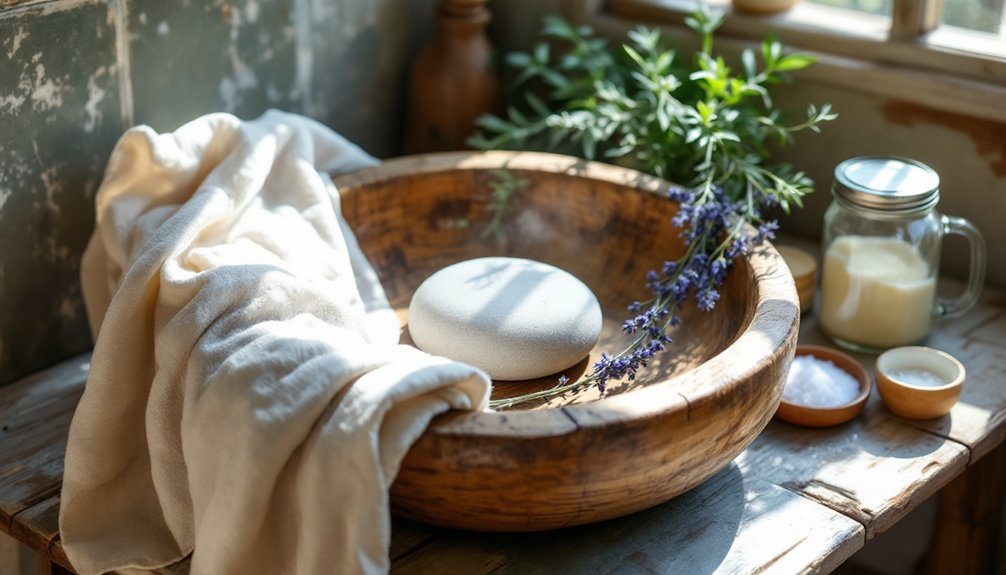



Leave a Reply